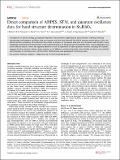Direct comparison of ARPES, STM, and quantum oscillation data for band structure determination in Sr2RhO4
Abstract
Discrepancies in the low-energy quasiparticle dispersion extracted from angle-resolved photoemission, scanning tunneling spectroscopy, and quantum oscillation data are common and have long haunted the field of quantum matter physics. Here, we directly test the consistency of results from these three techniques by comparing data from the correlated metal Sr2RhO4. Using established schemes for the interpretation of the experimental data, we find good agreement for the Fermi surface topography and carrier effective masses. Hence, the apparent absence of such an agreement in other quantum materials, including the cuprates, suggests that the electronic states in these materials are of different, non-Fermi liquid-like nature. Finally, we discuss the potential and challenges in extracting carrier lifetimes from photoemission and quasiparticle interference data.
Citation
Battisti , I , Tromp , W O , Riccò , S , Perry , R S , Mackenzie , A P , Tamai , A , Baumberger , F & Allan , M P 2020 , ' Direct comparison of ARPES, STM, and quantum oscillation data for band structure determination in Sr 2 RhO 4 ' , npj Quantum Materials , vol. 5 , 91 . https://doi.org/10.1038/s41535-020-00292-4
Publication
npj Quantum Materials
Status
Peer reviewed
ISSN
2397-4648Type
Journal article
Description
This work was supported by the UK-EPSRC under grant EP/G007357/1, by the Swiss National Science Foundation (SNSF) under grants 200020_165791 and 200020_184998, by the Max Planck Society, by the European Research Council (ERC StG SpinMelt), and by the Netherlands Organization for Scientific Research (NWO) under grants 680–47–536 and FOM-167. We acknowledge Diamond Light Source for time on beamline I05 under proposals no. SI13398 and SI5282.Collections
Items in the St Andrews Research Repository are protected by copyright, with all rights reserved, unless otherwise indicated.

